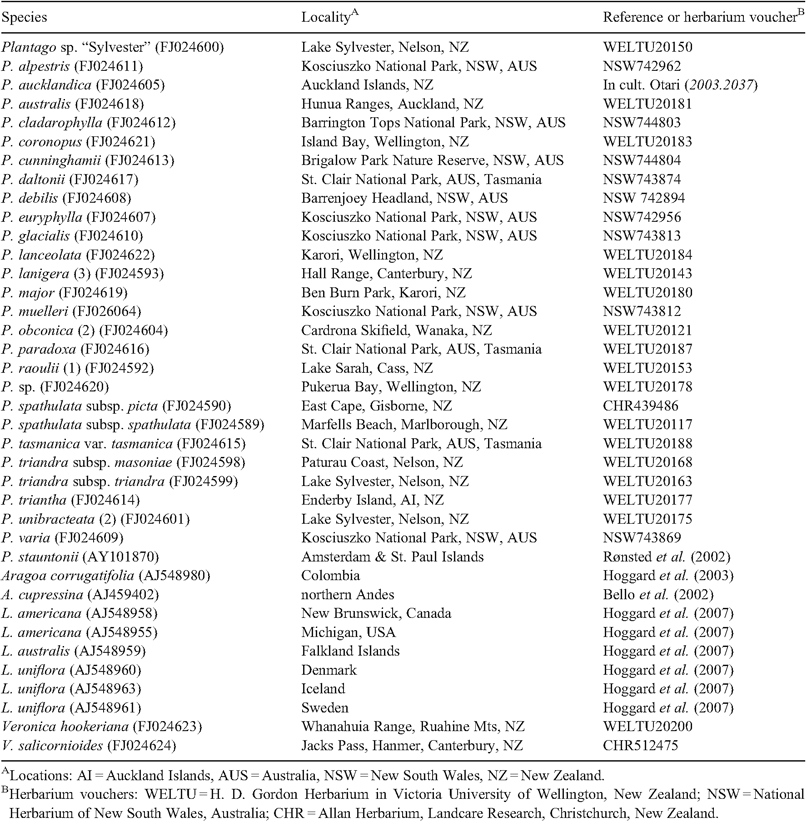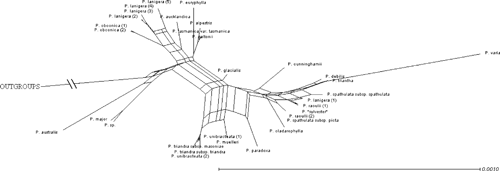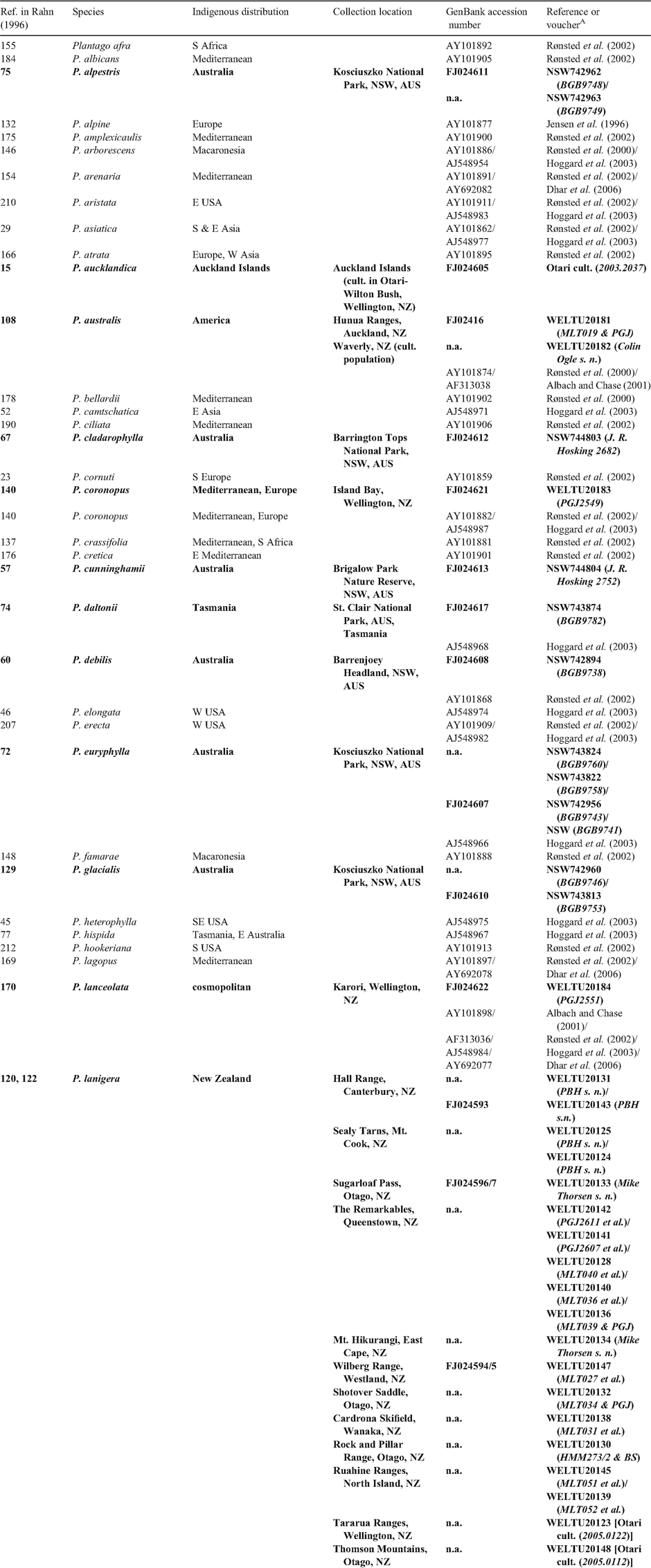DNA sequences from three genomes reveal multiple long-distance dispersals and non-monophyly of sections in Australasian Plantago (Plantaginaceae)
Mei Lin Tay A C , Heidi M. Meudt A B , Philip J. Garnock-Jones A and Peter A. Ritchie AA School of Biological Sciences, Victoria University of Wellington, PO Box 600, Wellington 6140, New Zealand.
B Museum of New Zealand, Te Papa Tongarewa, PO Box 467, Wellington 6140, New Zealand.
C Corresponding author. Email: meilin.tay@gmail.com
Australian Systematic Botany 23(1) 47-68 https://doi.org/10.1071/SB09040
Submitted: 15 September 2009 Accepted: 18 December 2009 Published: 17 February 2010
Abstract
We examined the geographic origins and taxonomic placements of New Zealand and Australian Plantago (Plantaginaceae) by using molecular phylogenetic data. Plantago comprises over 200 species distributed worldwide. Analyses of three markers from the nuclear (ITS), chloroplast (ndhF–rpl32) and mitochondrial (coxI) genomes showed that the New Zealand species form three distinct, well supported clades that are not each others’ closest relatives, and were each derived relative to the sampled Australian species. Therefore, at least three long-distance directional dispersal events into New Zealand can be inferred for Plantago, likely from Australian ancestors. This result differs from the biogeographic pattern often reported for New Zealand plant genera of a single dispersal event followed by rapid radiation, and may be attributed to ready biotic dispersal of mucilaginous seeds and habitat similarities of the Australasian species. Molecular dating placed the arrival time and diversification of the New Zealand species between 2.291 and 0.5 million years ago, which coincides with the geological dates for the uplift of mountain ranges in New Zealand. The mitochondrial DNA substitution rate of the Australasian clade relative to the rest of the genus is discussed, as well as implications of the non-monophyly of sections Oliganthos, Mesembrynia and Plantago within subgenus Plantago.
Additional keywords: biogeography, cpDNA, dispersal, molecular dating, molecular phylogeny, mtDNA, nrDNA.
Acknowledgements
The authors thank Lara Shepherd, Vincent Woo and Stephanie Greaves at the Victoria University Molecular Ecology Laboratory, and Lesley Milicich for technical support. We also thank Barbara Briggs, Lara Shepherd, Leon Perrie, Bill Malcolm, Nancy Malcolm, Kerry Ford, Colin Ogle, Peter Heenan, Peter Lockhart, Barry Sneddon, Mike Thorsen, Peter Beveridge, Rodney Lewington, Ines Schönberger and Rewi Elliot for help with sample collection; and Barbara Briggs (National Herbarium of New South Wales) and Allan Herbarium (CHR), Landcare Research, Lincoln, Canterbury, for supplying information about morphology and geographic distributions of Plantago during the course of this research. For financial support, we acknowledge the following: the Morton family (the Alison Morton Postgraduate Scholarship for Ecology and Marine Biology), New Zealand Foundation for Research Science and Technology through the Defining New Zealand’s Land Biota OBI, the Wellington Botanical Society, and Victoria University of Wellington (the VUW Post Graduate Scholarship for Masters Study, VUW Small Grants Scheme).
Albach DC,
Utteridge T, Wagstaff SJ
(2005) Origin of Veroniceae (Plantaginaceae, formerly Scrophulariaceae) on New Guinea. Systematic Botany 30, 412–423.
| Crossref | GoogleScholarGoogle Scholar |

Breitwieser I,
Glenny D,
Thorne A, Wagstaff SJ
(1999) Phylogenetic relationships in Australasian Gnaphalieae (Compositae) inferred from ITS sequences. New Zealand Journal of Botany 37, 399–412.

Briggs BG
(1973) Chromosomal studies on Plantago in Australia. Contributions from the NSW National Herbarium 4, 399–405.

Cho Y,
Mower JP,
Qiu YL, Palmer JD
(2004) Mitochondrial substitution rates are extraordinarily elevated and variable in a genus of flowering plants. Proceedings of the National Academy of Sciences, USA 101, 17741–17746.
| Crossref | GoogleScholarGoogle Scholar |
CAS |

Cooper A, Cooper RA
(1995) The Oligocene bottleneck and New-Zealand biota: genetic record of a past environmental crisis. Proceedings of the Royal Society of London. Series B. Biological Sciences 261, 293–302.
| Crossref | GoogleScholarGoogle Scholar |
CAS |

Crisp MD,
Arroyo MTK,
Cook LG,
Gandolfo MA,
Jordan GJ,
McGlone MS,
Weston PH,
Westoby M,
Wilf P, Linder HP
(2009) Phylogenetic biome conservatism on a global scale. Nature 458, 754–756.
| Crossref | GoogleScholarGoogle Scholar |
CAS |
PubMed |

Dawson MI
(1989) Contributions to a chromosome atlas of the New Zealand flora – 30 miscellaneous species. New Zealand Journal of Botany 27, 163–165.

Doyle JJ, Doyle JD
(1990) Isolation of plant DNA from fresh tissue. Focus 12, 13–15.

Drummond AJ, Rambaut A
(2007) BEAST: Bayesian evolutionary analysis by sampling trees. BMC Evolutionary Biology 7, 214.
| Crossref | GoogleScholarGoogle Scholar | PubMed |

Drummond AJ,
Ho SYW,
Phillips MJ, Rambaut A
(2006) Relaxed phylogenetics and dating with confidence. PLoS Biology 4, 699–710.
| Crossref | GoogleScholarGoogle Scholar |
CAS |

Dunbar-Co S,
Wieczorek AM, Morden CW
(2008) Molecular phylogeny and adaptive radiation of the endemic Hawaiian Plantago species (Plantaginaceae). American Journal of Botany 95, 1177–1188.
| Crossref | GoogleScholarGoogle Scholar |
CAS |

Felsenstein J
(1981) Evolutionary trees from DNA-sequences – a maximum-likelihood approach. Journal of Molecular Evolution 17, 368–376.
| Crossref | GoogleScholarGoogle Scholar |
CAS |
PubMed |

Ford KA,
Ward JM,
Smissen RD,
Wagstaff SJ, Breitwieser I
(2007) Phylogeny and biogeography of Craspedia (Asteraceae: Gnaphalieae) based on ITS, ETS and psbA–trnH sequence data. Taxon 56, 783–794.

Garnock-Jones PJ,
Albach DC, Briggs BG
(2007) Botanical names in southern hemisphere Veronica (Plantaginaceae): sect. Detneria, sect. Hebe, and sect. Labiatoides. Taxon 56, 571–582.

Groves BE, Hair JB
(1971) Contributions to a chromosome atlas of the New Zealand flora – 15 miscellaneous families. New Zealand Journal of Botany 9, 569–575.

Hardy CR,
Moline P, Linder HP
(2008) A phylogeny for the African Restionaceae and new perspectives on morphology’s role in generating complete species phylogenies for large clades. International Journal of Plant Sciences 169, 377–390.
| Crossref | GoogleScholarGoogle Scholar |

Heenan PB,
Mitchell AD, Koch M
(2002) Molecular systematics of the New Zealand Pachycladon (Brassicaceae) complex: generic circumscription and relationship to Arabidopsis sens. lat. and Arabis sens. lat. New Zealand Journal of Botany 40, 543–562.

Hoggard RK,
Kores PJ,
Molvray M,
Hoggard GD, Broughton DA
(2003) Molecular systematics and biogeography of the amphibious genus Littorella (Plantaginaceae). American Journal of Botany 90, 429–435.
| Crossref | GoogleScholarGoogle Scholar |

Huelsenbeck JP, Ronquist F
(2001) MRBAYES: Bayesian inference of phylogenetic trees. Bioinformatics 17, 754–755.
| Crossref | GoogleScholarGoogle Scholar |
CAS |
PubMed |

Huson DH, Bryant D
(2006) Application of phylogenetic networks in evolutionary studies. Molecular Biology and Evolution 23, 254–267.
| Crossref | GoogleScholarGoogle Scholar |
CAS |
PubMed |

Ishikawa N,
Yokoyama J, Tsukaya H
(2009) Molecular evidence of reticulate evolution in the subgenus Plantago (Plantaginaceae). American Journal of Botany 96, 1627–1635.
| Crossref | GoogleScholarGoogle Scholar |
CAS |

Knapp M,
Stöckler K,
Havell D,
Delsuc F,
Sebastiani F, Lockhart PJ
(2005) Relaxed molecular clock provides evidence for long-distance dispersal of Nothofagus (southern beech). PLoS Biology 3, 38–43.
| Crossref | GoogleScholarGoogle Scholar |
CAS |

Knapp M,
Mudaliar R,
Havell D,
Wagstaff SJ, Lockhart PJ
(2007) The drowning of New Zealand and the problem of Agathis. Systematic Biology 56, 862–870.
| Crossref | GoogleScholarGoogle Scholar | PubMed |

Kumar S,
Tamura K, Nei M
(2004) MEGA3: Integrated software for molecular evolutionary genetics analysis and sequence alignment. Briefings in Bioinformatics 5, 150–163.
| Crossref | GoogleScholarGoogle Scholar |
CAS |
PubMed |

Lockhart PJ,
McLenachan PA,
Havell D,
Glenny D,
Huson D, Jensen U
(2001) Phylogeny, radiation, and transoceanic dispersal of New Zealand alpine buttercups: molecular evidence under split decomposition. Annals of the Missouri Botanical Garden 88, 458–477.
| Crossref | GoogleScholarGoogle Scholar |

Manos PS,
Doyle JJ, Nixon KC
(1999) Phylogeny, biogeography, and processes of molecular differentiation in Quercus subgenus Quercus (Fagaceae). Molecular Phylogenetics and Evolution 12, 333–349.
| Crossref | GoogleScholarGoogle Scholar |
CAS |
PubMed |

Manzano P, Malo JE
(2006) Extreme long-distance seed dispersal via sheep. Frontiers in Ecology and the Environment 4, 244–248.
| Crossref | GoogleScholarGoogle Scholar |

McBreen K, Lockhart PJ
(2006) Reconstructing reticulate evolutionary histories of plants. Trends in Plant Science 11, 398–404.
| Crossref | GoogleScholarGoogle Scholar |
CAS |
PubMed |

McDowall RM
(2008) Process and pattern in the biogeography of New Zealand – a global microcosm? Journal of Biogeography 35, 197–212.
| Crossref |

Meudt HM, Bayly MJ
(2008) Phylogeographic patterns in the Australasian genus Chionohebe (Veronica s.l., Plantaginaceae) based on AFLP and chloroplast DNA sequences. Molecular Phylogenetics and Evolution 47, 319–338.
| Crossref | GoogleScholarGoogle Scholar |
CAS |
PubMed |

Meudt HM, Simpson BB
(2006) The biogeography of the austral, subalpine genus Ourisia (Plantaginaceae) based on molecular phylogenetic evidence: South American origin and dispersal to New Zealand and Tasmania. Biological Journal of the Linnean Society. Linnean Society of London 87, 479–513.
| Crossref | GoogleScholarGoogle Scholar |

Morgan-Richards M,
Smissen RD,
Shepherd LD,
Wallis GP,
Hayward JJ,
Chan C-h,
Chambers GK, Chapman HM
(2009) A review of genetic analyses of hybridisation in New Zealand. Journal of the Royal Society of New Zealand 39, 15–34.

Müller K
(2005) SeqState: primer design and sequence statistics for phylogenetic DNA datasets. Applied Bioinformatics 4, 65–69.
| Crossref |
PubMed |

Muñoz J,
Felicísimo AM,
Cabezas F,
Burgaz AR, Martínez I
(2004) Wind as a long-distance dispersal vehicle in the southern hemisphere. Science 304, 1144–1147.
| Crossref | GoogleScholarGoogle Scholar | PubMed |

Murray BG,
Datson PM,
Lai EL,
Sheath KM, Cameron EK
(2004) Polyploidy, hybridization and evolution in Pratia (Campanulaceae). New Zealand Journal of Botany 42, 905–920.

Nelson GJ
(1975) Review: Biogeography, the vicariance paradigm, and continental drift. Systematic Zoology 24, 490–504.
| Crossref | GoogleScholarGoogle Scholar |

Perrie LR, Brownsey PJ
(2007) Molecular evidence for long-distance dispersal in the New Zealand pteridophyte flora. Journal of Biogeography 34, 2028–2038.
| Crossref | GoogleScholarGoogle Scholar |

Perrie LR,
Brownsey P,
Lockhart PJ,
Brown EA, Large MF
(2003) Biogeography of temperate Australasian Polystichum ferns as inferred from chloroplast sequence and AFLP. Journal of Biogeography 30, 1729–1736.
| Crossref | GoogleScholarGoogle Scholar |

Perrie LR,
Bayly MJ,
Lehnebach CA, Brownsey PJ
(2007) Molecular phylogenetics and molecular dating of the New Zealand Gleicheniaceae. Brittonia 59, 129–141.
| Crossref | GoogleScholarGoogle Scholar |

Pole M
(1994) The New-Zealand flora – entirely long-distance dispersal. Journal of Biogeography 21, 625–635.
| Crossref | GoogleScholarGoogle Scholar |

Posada D, Buckley TR
(2004) Model selection and model averaging in phylogenetics: advantages of akaike information criterion and Bayesian approaches over likelihood ratio tests. Systematic Biology 53, 793–808.
| Crossref | GoogleScholarGoogle Scholar | PubMed |

Posada D, Crandall KA
(1998) MODELTEST: testing the model of DNA substitution. Bioinformatics (Oxford, England) 14, 817–818.
| Crossref | GoogleScholarGoogle Scholar |
CAS |
PubMed |

Rahn K
(1984)
Plantago sect. Oliganthos in southern South America, a taxonomic revision. Nordic Journal of Botany 4, 601–627.
| Crossref | GoogleScholarGoogle Scholar |

Rahn K
(1996) A phylogenetic study of the Plantaginaceae. Botanical Journal of the Linnean Society 120, 145–198.

Raven PH
(1973) Evolution of subalpine and alpine plant groups in New Zealand. New Zealand Journal of Botany 11, 177–200.

Reeves G,
Chase MW,
Goldblatt P,
Rudall P,
Fay MF,
Cox AV,
Lejeune B, Souza-Chies T
(2001) Molecular systematics of Iridaceae: evidence from four plastid DNA regions. American Journal of Botany 88, 2074–2087.
| Crossref | GoogleScholarGoogle Scholar |
CAS |

Rivadavia F,
Kondo K,
Kato M, Hasebe M
(2003) Phylogeny of the sundews, Drosera (Droseraceae), based on chloroplast rbcL and nuclear 18S ribosomal DNA sequences. American Journal of Botany 90, 123–130.
| Crossref | GoogleScholarGoogle Scholar |
CAS |

Rønsted N,
Chase MW,
Albach DC, Bello MA
(2002) Phylogenetic relationships within Plantago (Plantaginaceae): evidence from nuclear ribosomal ITS and plastid trnL-F sequence data. Botanical Journal of the Linnean Society 139, 323–338.
| Crossref | GoogleScholarGoogle Scholar |

Sanmartín I, Ronquist F
(2004) Southern hemisphere biogeography inferred by event-based models: plant versus animal patterns. Systematic Biology 53, 216–243.
| Crossref | GoogleScholarGoogle Scholar | PubMed |

Sanmartín I,
Wanntorp L, Winkworth RC
(2007) West wind drift revisited: testing for directional dispersal in the Southern Hemisphere using event-based tree fitting. Journal of Biogeography 34, 398–416.
| Crossref | GoogleScholarGoogle Scholar |

Shaw J,
Lickey EB,
Schilling EE, Small RL
(2007) Comparison of whole chloroplast genome sequences to choose noncoding regions for phylogenetic studies in angiosperms: the tortoise and the hare III. American Journal of Botany 94, 275–288.
| Crossref | GoogleScholarGoogle Scholar |
CAS |

Simmons MP,
Müller K, Norton AP
(2007) The relative performance of indel-coding methods in simulations. Molecular Phylogenetics and Evolution 44, 724–740.
| Crossref | GoogleScholarGoogle Scholar |
CAS |
PubMed |

Smissen RD,
Garnock-Jones PJ, Chambers GK
(2003) Phylogenetic analysis of ITS sequences suggests a Pliocene origin for the bipolar distribution of Scleranthus (Caryophyllaceae). Australian Systematic Botany 16, 301–315.
| Crossref | GoogleScholarGoogle Scholar |
CAS |

Spence JR, Sykes WR
(1989) Are Plantago novae-zelandiae L.Moore and P. lanigera Hook.f. (Plantaginaceae) different? New Zealand Journal of Botany 27, 499–502.

Stöckler K,
Daniel IL, Lockhart PJ
(2002) New Zealand Kauri (Agathis australis (D.Don) Lindl., Araucariaceae) survives Oligocene drowning. Systematic Biology 51, 827–832.
| Crossref | GoogleScholarGoogle Scholar | PubMed |

Sykes WR
(1988) Notes on New Zealand Plantago Species. New Zealand Journal of Botany 26, 321–323.

Sytsma KJ,
Litt A,
Zijhra ML,
Pires JC,
Nepokroeff M,
Conti E,
Walker J, Wilson PG
(2004) Clades, clocks, and continents: historical and biogeographical analysis of Myrtaceae, Vochysiaceae, and relatives in the southern hemisphere. International Journal of Plant Sciences 165, S85–S105.
| Crossref | GoogleScholarGoogle Scholar |
CAS |

Trewick SA,
Paterson AM, Campbell HJ
(2007) Hello New Zealand. Journal of Biogeography 34, 1–6.
| Crossref | GoogleScholarGoogle Scholar |

von Hagen KB, Kadereit JW
(2001) The phylogeny of Gentianella (Gentianaceae) and its colonization of the southern hemisphere as revealed by nuclear and chloroplast DNA sequence variation. Organisms, Diversity & Evolution 1, 61–79.
| Crossref | GoogleScholarGoogle Scholar |

Vriesendorp B, Bakker FT
(2005) Reconstructing patterns of reticulate evolution in angiosperms: what can we do? Taxon 54, 593–604.

Wagstaff SJ, Garnock-Jones PJ
(1998) Evolution and biogeography of the Hebe complex (Scrophulariaceae) inferred from ITS sequences. New Zealand Journal of Botany 36, 425–437.

Wagstaff SJ, Garnock-Jones PJ
(2000) Patterns of diversification in Chionohebe and Parahebe (Scrophulariaceae) inferred from ITS sequences. New Zealand Journal of Botany 38, 389–407.

Wagstaff SJ, Wege J
(2002) Patterns of diversification in New Zealand Stylidiaceae. American Journal of Botany 89, 865–874.
| Crossref | GoogleScholarGoogle Scholar |

Wagstaff SJ,
Heenan PB, Sanderson MJ
(1999) Classification, origins, and patterns of diversification in New Zealand Carmichaelinae (Fabaceae). American Journal of Botany 86, 1346–1356.
| Crossref | GoogleScholarGoogle Scholar |
CAS |
PubMed |

Wagstaff SJ,
Bayly MJ,
Garnock-Jones PJ, Albach DC
(2002) Classification, origin, and diversification of the New Zealand hebes (Scrophulariaceae). Annals of the Missouri Botanical Garden 89, 38–63.
| Crossref | GoogleScholarGoogle Scholar |

Wanntorp L, Wanntorp H-E
(2003) The biogeography of Gunnera L.: vicariance and dispersal. Journal of Biogeography 30, 979–987.

Winkworth RC,
Robertson AW,
Ehrendorfer F, Lockhart PJ
(1999) The importance of dispersal and recent speciation in the flora of New Zealand. Journal of Biogeography 26, 1323–1325.
| Crossref | GoogleScholarGoogle Scholar |

Winkworth RC,
Grau J,
Robertson AW, Lockhart PJ
(2002a) The origins and evolution of the genus Myosotis L. (Boraginaceae). Molecular Phylogenetics and Evolution 24, 180–193.
| Crossref | GoogleScholarGoogle Scholar | PubMed |

Winkworth RC,
Wagstaff SJ,
Glenny D, Lockhart PJ
(2002b) Plant dispersal NEWS from New Zealand. Trends in Ecology & Evolution 17, 514–520.
| Crossref | GoogleScholarGoogle Scholar |

Wolfe KH,
Li WH, Sharp PM
(1987) Rates of nucleotide substitution vary greatly among plant mitochondrial, chloroplast, and nuclear DNAs. Proceedings of the National Academy of Sciences, USA 84, 9054–9058.
| Crossref | GoogleScholarGoogle Scholar |
CAS |

Xia X, Xie Z
(2001) DAMBE: software package for data analysis in molecular biology and evolution. Journal of Heredity 92, 371–373.
| Crossref | GoogleScholarGoogle Scholar |
CAS |
PubMed |

Yoder AD,
Irwin JA, Payseur BA
(2001) Failure of the ILD to determine data combinability for slow loris phylogeny. Systematic Biology 50, 408–424.
| Crossref | GoogleScholarGoogle Scholar |
CAS |
PubMed |


|

|

|



